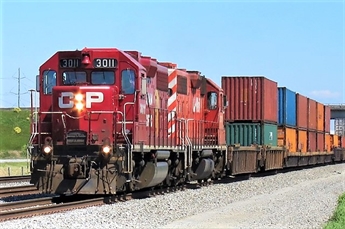Railway - The fundamentals
News Mediarail.be
Introduction of the introduction...
> Introduction to the railway sector
> The transformation of the railway sector
> Basics of rail transport technology
> The transformation of the railway sector
> Basics of rail transport technology
The author:
Frédéric de Kemmeter
Railway signalling systems. I'm a rail observer for over 30 years. How has the railway evolved over the decades? Which futur for railways? That's what I'm analyzing and explaining.
Railway signalling systems. I'm a rail observer for over 30 years. How has the railway evolved over the decades? Which futur for railways? That's what I'm analyzing and explaining.

A brief history
The train is above all a guided transport. Its origins are lost in history. According to some sources, the first rails were ruts in roads of the Minoan era of the 2nd millennium and those of Babylon in the 7th century BC! These principles reappear much later in the 15th century in European coalmines. The rails were made of wood and then replaced by cast iron rails.
>>> Small history of the railway
The locomotive machine is a more recent invention. Nicolas Cugnot, a French engineer, was the first to install a "non-animal" engine on his famous steam engine in 1769. Without achieving great success. The history of the "railway" begins rather with animal traction, as be seen early 1792 on the Little Eaton Railway in the United Kingdom: cast iron rails on which small vehicles, called "wagons", run. "Train" comes from a French verb that meant "to draw or drag" and has been part of English since the 14th century—since its Middle English days. At this time, it referred to the part of a gown that trailed behind the wearer... To eliminate horse traction, it was necessary to wait for improvements in the efficiency of the steam engine, which had been lacking at Cugnot. The Welshman Richard Trevithick found a machine that had at least the same efficiency as horses, an indispensable condition to make the machine accepted in a world dominated by horses. Thanks to innovations made by George Stephenson, an English engineer, it made possible to exceed the horse's performance early 1825, the year considered to be that of the first non-animal and self-propelled train. A revolution was underway...
>>> Small history of the railway
The locomotive machine is a more recent invention. Nicolas Cugnot, a French engineer, was the first to install a "non-animal" engine on his famous steam engine in 1769. Without achieving great success. The history of the "railway" begins rather with animal traction, as be seen early 1792 on the Little Eaton Railway in the United Kingdom: cast iron rails on which small vehicles, called "wagons", run. "Train" comes from a French verb that meant "to draw or drag" and has been part of English since the 14th century—since its Middle English days. At this time, it referred to the part of a gown that trailed behind the wearer... To eliminate horse traction, it was necessary to wait for improvements in the efficiency of the steam engine, which had been lacking at Cugnot. The Welshman Richard Trevithick found a machine that had at least the same efficiency as horses, an indispensable condition to make the machine accepted in a world dominated by horses. Thanks to innovations made by George Stephenson, an English engineer, it made possible to exceed the horse's performance early 1825, the year considered to be that of the first non-animal and self-propelled train. A revolution was underway...
See also:
• My photos on Piwigo gallery
• My YouTube channel
• My blog with latest news
• Follow me on Twitter and LinkedIn
• My photos on Piwigo gallery
• My YouTube channel
• My blog with latest news
• Follow me on Twitter and LinkedIn
Introduction to the railway sector
Rail is a form of transport characterized by two technical subsystems which must be compatible with each other:
• the Infrastructure subsystem, consisting of the track, signalling for safety and possibly the catenary to provide traction energy by capture;
• the Rolling Stock subsystem, which comprises the vehicles which must be fitted with flanged wheels in order to run on the railway track made up of rails.
This presentation helps to demonstrate the big difference with other transport: on the road, wheels with rubber tyres; on the water, enogh hull support to float; and in the air, enough wing configuration and speed to overcome the earth attraction and to fly. These three forms of transport are also compatible, but they are more flexible than rail transport. Road vehicles can run anywhere, even on grass; airplanes can fly anywhere in the sky, which is a natural infrastructure; ships can sail anywhere, thanks to the natural infrastructure of "rivers, seas and oceans", with exception of canals, which are a man-made infrastructure.
This fundamental feature of the rail-wheel system has made the railway a transportation managed as a single industrial entity. Whereas the other three competing transport modes have separate infrastructure/vehicle management, with of course a minimal compatibility via standards limiting gauges, speed and weight. There is more freedom in the three competing modes of transport, which is more less in the rail sector.
To this railway technical scheme, we should add a second one: that of the elements of competitiveness of the rail system. We have seen above that motorization only becomes useful if it goes beyond horse traction, a mode of transport that goes back to the night of time and which seemed to be enough for everyone. But there are other advantages as well. The elements of competitiveness of the rail system therefore include:
• transportation capacity, which must be greater than all the railroad's competitors;
• the speed of transportation, which must be greater than all the railway's land-based competitors;
• the quality of service, which must be at least equal to all the railway's competitors.
If any one of these three elements is lacking, the railway system would be in trouble justifying its technology and its use. We know it has always had to justify its advantages. So far it has been successful...
• the Infrastructure subsystem, consisting of the track, signalling for safety and possibly the catenary to provide traction energy by capture;
• the Rolling Stock subsystem, which comprises the vehicles which must be fitted with flanged wheels in order to run on the railway track made up of rails.
This presentation helps to demonstrate the big difference with other transport: on the road, wheels with rubber tyres; on the water, enogh hull support to float; and in the air, enough wing configuration and speed to overcome the earth attraction and to fly. These three forms of transport are also compatible, but they are more flexible than rail transport. Road vehicles can run anywhere, even on grass; airplanes can fly anywhere in the sky, which is a natural infrastructure; ships can sail anywhere, thanks to the natural infrastructure of "rivers, seas and oceans", with exception of canals, which are a man-made infrastructure.
This fundamental feature of the rail-wheel system has made the railway a transportation managed as a single industrial entity. Whereas the other three competing transport modes have separate infrastructure/vehicle management, with of course a minimal compatibility via standards limiting gauges, speed and weight. There is more freedom in the three competing modes of transport, which is more less in the rail sector.
To this railway technical scheme, we should add a second one: that of the elements of competitiveness of the rail system. We have seen above that motorization only becomes useful if it goes beyond horse traction, a mode of transport that goes back to the night of time and which seemed to be enough for everyone. But there are other advantages as well. The elements of competitiveness of the rail system therefore include:
• transportation capacity, which must be greater than all the railroad's competitors;
• the speed of transportation, which must be greater than all the railway's land-based competitors;
• the quality of service, which must be at least equal to all the railway's competitors.
If any one of these three elements is lacking, the railway system would be in trouble justifying its technology and its use. We know it has always had to justify its advantages. So far it has been successful...

In land transport, trains have a greater transport capacity than road vehicles and inland navigation (although...). The advantage of guided transport is that they can pull (or push) many vehicles, freight wagons or passenger cars without deflecting of his way. These "trains" therefore have a very large carrying capacity, which is their undeniable advantage: we can see how many people can carry per hour in a commuter's train. We also can see the length of freight trains on certain continents and sometimes their availability to carry double-deck containers, which multiplies the tonnages.

The speed of transport is only for passenger trains. Indeed, the passenger wants to travel as quickly as possible. The greater the distance, the faster he wants to travel, which is made possible by high-speed rail, once again thanks to guided transport. Without high speed, an "acceptable" travel time also encourages people to take the train rather than the car. However, the train has no chance in terms of speed to compete over long distances with the airliners, especially when you must to cross an ocean...
In freight transport, what matters most to shippers is rather the frequency of trains during the week and the respect of deadlines for the routing of goods.
In freight transport, what matters most to shippers is rather the frequency of trains during the week and the respect of deadlines for the routing of goods.
Quality of service is the almost central element, and this applies to all types of transport. Indeed, high quality makes it possible to "compensate" for the shortcomings of rail transport. The service on board passenger trains must be superior to that of its competitors, for example breakfast in sleeping cars or widespread Wi-Fi on board. Quality of service also means simple, digitally-accessible fares, full information and reimbursement in the event of major disruptions.
In freight transport, the respect of deadlines for the routing of goods as well as their pricing are crucial elements of quality for the industry.
In freight transport, the respect of deadlines for the routing of goods as well as their pricing are crucial elements of quality for the industry.

Railways in a changing world
The interweaving of the rail-wheel systems and the rigidity of the technical interfaces meant that this transport was generally managed as a single industrial entity, and therefore as a single transport company. But no matter how efficient it was, the railways were faced with the end of their monopoly early of the 1950s. Little by little, people subscribed to the way of life of the second industrial revolution: oil, cars and planes. The railways then began to become increasingly marginalized and they became gradually a minority transport system, as some people wondered whether they would survive the 21st century. The industry has also changed and has set a new logistics organization which is not favorable to railways. The train was less and less suitable.
Despite heavy modernisation efforts, with the electrification of Europe's networks renewing all rolling stock, rail's market share fell dangerously, stabilising in the 1980s at a very low level. The fact is that during the postwar era, the railways thought they could live in a closed-circuit system, away from the transformations of the second industrial revolution. This was particularly the case for railway workers, to whom States had provided a more generous social framework outside the ordinary social law, and which was to give a lot of trouble the governments of the 1990s and 2000s when it was be necessary to transform of railway companies into "enterprise". The railways had to renew themselves at all costs. A revitalization was necessary...
Despite heavy modernisation efforts, with the electrification of Europe's networks renewing all rolling stock, rail's market share fell dangerously, stabilising in the 1980s at a very low level. The fact is that during the postwar era, the railways thought they could live in a closed-circuit system, away from the transformations of the second industrial revolution. This was particularly the case for railway workers, to whom States had provided a more generous social framework outside the ordinary social law, and which was to give a lot of trouble the governments of the 1990s and 2000s when it was be necessary to transform of railway companies into "enterprise". The railways had to renew themselves at all costs. A revitalization was necessary...
The transformation of the railway sector
We stand on the brink of a technological revolution that will fundamentally alter the way we live and work. This revolution, which is already underway, is characterized by a fusion of technologies that blurs the boundaries between the physical, digital and biological spheres. These changes will involve developments whose scope we do not yet know. They affect all sectors, and the railway will be impacted in one way or another.
We can identify three main themes that make up the world to come:
We can identify three main themes that make up the world to come:

The idea of transforming our old railways also comes, in addition to the above, from a more mundane reality:
• A desire to revitalize the sector other than by maintaining operating processes that had become obsolete and very costly to taxpayers, whilst the contribution to society was becoming very minimalist (traffic, climate, ...);
• A desire to reduce public finances;
• A desire from business world to entry in a sector in which it was generally absent, believing that there were niches markets in the railways to create new markets.
Nevertheless, there has been hope that the railways will entry into the 21st century. At the end of the 1980s, Europe had gained much more power and could now lay down rules. It took more than 25 years to agree on a railway policy which required the development of four legislative packages.
The arrival of Europe has also affirmed the importance of the regionalization of transport, in countries which have a appropriate institutional framework, mainly those of Northern Europe. New players have emerged on the railway scene as the industry has taken the lead in technological design, previously held by the incumbent companies. The industrial world has also published a whole framework of standards which have the advantage of enabling an industrialist to sell its trains throughout Europe, and no longer only on national territory as a subcontractor. This has led to the creation of certification bodies. This fragmentation makes it necessary to distinguish the main players:
• public authorities such as States, Regions, Lander, Counties and any transport organization;
• economic players such as the railway industry, operating companies and infrastructure managers;
• facilitators such as standardization bodies (ISO, CENELEC, etc.) and research organizations.
This presentation shows that the railways are much more fragmented that it is stated, despite the strong rail-wheel interdependence mentioned above and their integrated management.
The transformation of the railway, its financing and its transport policy can also be understood if, in addition to the actors mentioned above, the railway system is seen as a whole. The railway is in fact four sectors which, although they are highly interconnected at the technical level, each have their own life and business model:
• A railway infrastructure;
• Local and regional trains for daily commuters;
• Mainline trains for business and tourism segment;
• Freight trains for trade and industry.
• A desire to revitalize the sector other than by maintaining operating processes that had become obsolete and very costly to taxpayers, whilst the contribution to society was becoming very minimalist (traffic, climate, ...);
• A desire to reduce public finances;
• A desire from business world to entry in a sector in which it was generally absent, believing that there were niches markets in the railways to create new markets.
Nevertheless, there has been hope that the railways will entry into the 21st century. At the end of the 1980s, Europe had gained much more power and could now lay down rules. It took more than 25 years to agree on a railway policy which required the development of four legislative packages.
The arrival of Europe has also affirmed the importance of the regionalization of transport, in countries which have a appropriate institutional framework, mainly those of Northern Europe. New players have emerged on the railway scene as the industry has taken the lead in technological design, previously held by the incumbent companies. The industrial world has also published a whole framework of standards which have the advantage of enabling an industrialist to sell its trains throughout Europe, and no longer only on national territory as a subcontractor. This has led to the creation of certification bodies. This fragmentation makes it necessary to distinguish the main players:
• public authorities such as States, Regions, Lander, Counties and any transport organization;
• economic players such as the railway industry, operating companies and infrastructure managers;
• facilitators such as standardization bodies (ISO, CENELEC, etc.) and research organizations.
This presentation shows that the railways are much more fragmented that it is stated, despite the strong rail-wheel interdependence mentioned above and their integrated management.
The transformation of the railway, its financing and its transport policy can also be understood if, in addition to the actors mentioned above, the railway system is seen as a whole. The railway is in fact four sectors which, although they are highly interconnected at the technical level, each have their own life and business model:
• A railway infrastructure;
• Local and regional trains for daily commuters;
• Mainline trains for business and tourism segment;
• Freight trains for trade and industry.

Mainline
Freight
Local / Regional
Infrastructure
This configuration is crucial to understanding who finances what in the railway system. Because the reforms that have been undertaken since the 1990s, particularly through European directives, also aimed to see how funding can be shared between the public and private sectors, because public authorities were faced with new uses and increasingly constrained public funding. The European competition laws, in which the railways are now involved, give Europe a right of control over which sectors can still be subsidized and which can no longer. That is why the diagram above shows two frameworks:
• In blue, we have the two sectors which are state or regional monopolies, which does not mean that they are managed as administrations. Local/regional train and infrastructure can only survive with subsidies, given their socio-economic environment, the intensity of expenditure and the associated social policies at the level of pricing, whereas in most cases revenues never cover operating costs;
• In yellow, the mainline and freight sectors, which were decided to be operated at market prices, i.e. without any subsidies other than one-off support measures.
• In blue, we have the two sectors which are state or regional monopolies, which does not mean that they are managed as administrations. Local/regional train and infrastructure can only survive with subsidies, given their socio-economic environment, the intensity of expenditure and the associated social policies at the level of pricing, whereas in most cases revenues never cover operating costs;
• In yellow, the mainline and freight sectors, which were decided to be operated at market prices, i.e. without any subsidies other than one-off support measures.








-WEc780af7f81.png)





